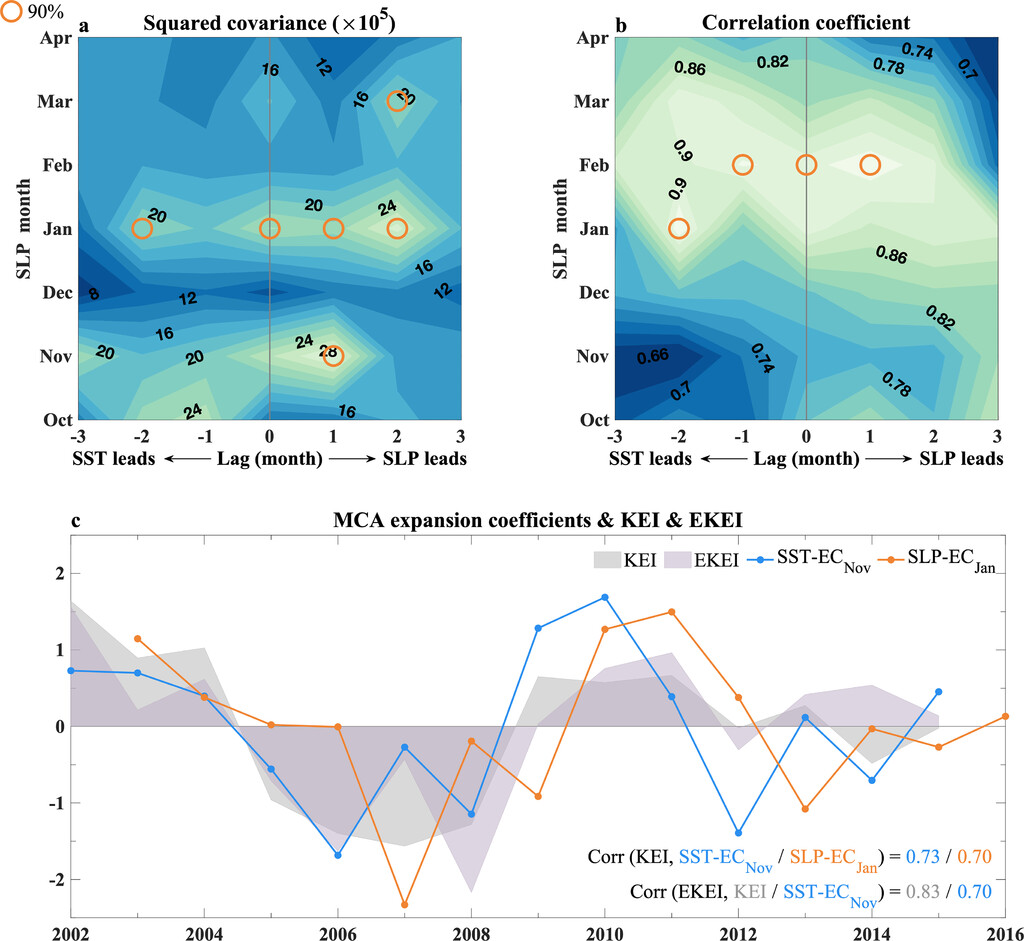A Mesoscale Ocean–Atmosphere Coupled Pathway for Decadal Variability of the Kuroshio Extension System
Bolan Gan, Tianyu Wang, Lixin Wu, Jianping Li, Bo Qiu, Haiyuan Yang, and Li Zhang
Published in Journal of Climate, January 2023
The Kuroshio Extension (KE) system has been observed to experience a decadal cycle between dynamically stable and unstable states. However, divergent conclusions on its interaction with the atmosphere obfuscate the understanding of its oscillatory nature at the preferred decadal time scale. Here, using satellite observations and the ERA-Interim reanalysis in 2002–16, physical process-oriented diagnoses suggest that the wintertime finer-scale thermodynamic response to mesoscale oceanic surface conditions and slow oceanic Rossby wave adjustment frame a coupled ocean–atmosphere delayed oscillator for the decadal KE variability. During the stable state of the KE system, the downstream KE transition region is rich in mesoscale oceanic warming associated with warm eddies, which induces surface wind convergence and upward motion, probably via the enhanced turbulent mixing. Meanwhile, increased finer-scale diabatic heating in the lower troposphere with abundant moisture supply from warmer water likely facilitates the deep-reaching updraft that adiabatically cools the middle troposphere. The background northwesterly wind helps to spread out the cooling, leading to southward deflection of local atmospheric eddy available potential energy (EAPE) production by baroclinic conversion. Consequently, the synoptic eddy activity displaces southward across the basin with additional energy supply from the increased diabatic production of EAPE downstream. Anomalous synoptic eddy thermal and vorticity forcing eventually fosters the basin-scale equivalent-barotropic cyclonic circulation anomaly, which is further maintained by energy conversion from the background state. The resultant wind-driven negative sea surface height anomalies propagate westward into the upstream KE region with a delay of ∼4 years and can trigger the unstable state of the KE system.

Fig. (a) Squared covariances (×105; dimensionless) of the first MCA modes associated with the monthly anomalies of SST (30°–45°N, 140°–175°E) and SLP (30°–55°N, 140°E–120°W), and (b) correlation coefficients between their corresponding expansion coefficients. The ordinate denotes calendar months of SLP, and the abscissa denotes time lag of SST in month (positive when SST lags SLP). Values significant at the 90% confidence level based on the Monte Carlo test are marked with orange circles. (c) The normalized SST-ECNov (cyan), SLP-ECJan (orange), the winter-season-mean (from October to March) KEI (gray shading), and the November EKEI (purple shading; see text for definition).
Gan, B., Wang, T., Wu, L., Li, J., Qiu, B., Yang, H., & Zhang, L. (2023). A Mesoscale Ocean–Atmosphere Coupled Pathway for Decadal Variability of the Kuroshio Extension System, Journal of Climate, 36(2), 485-510. https://doi.org/10.1175/JCLI-D-21-0557.1